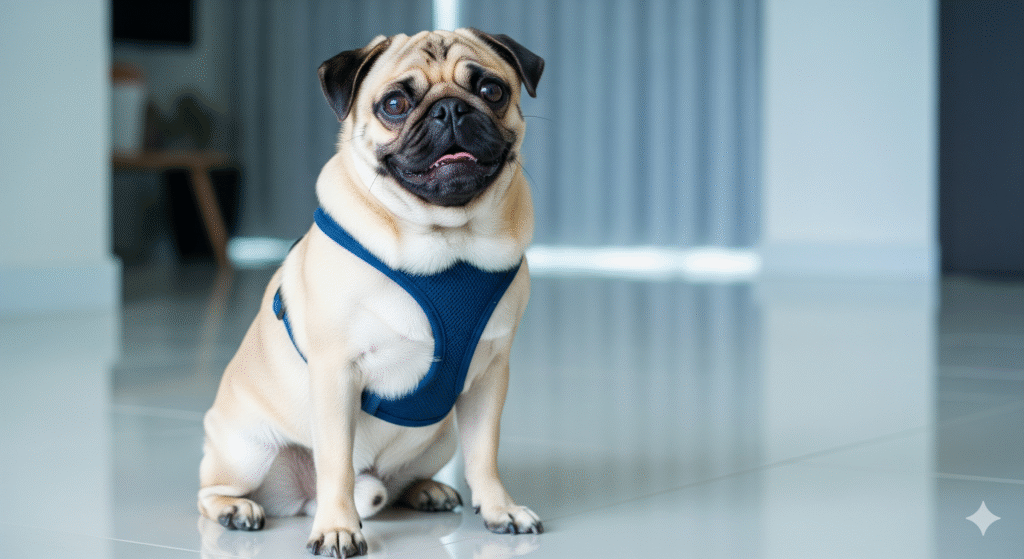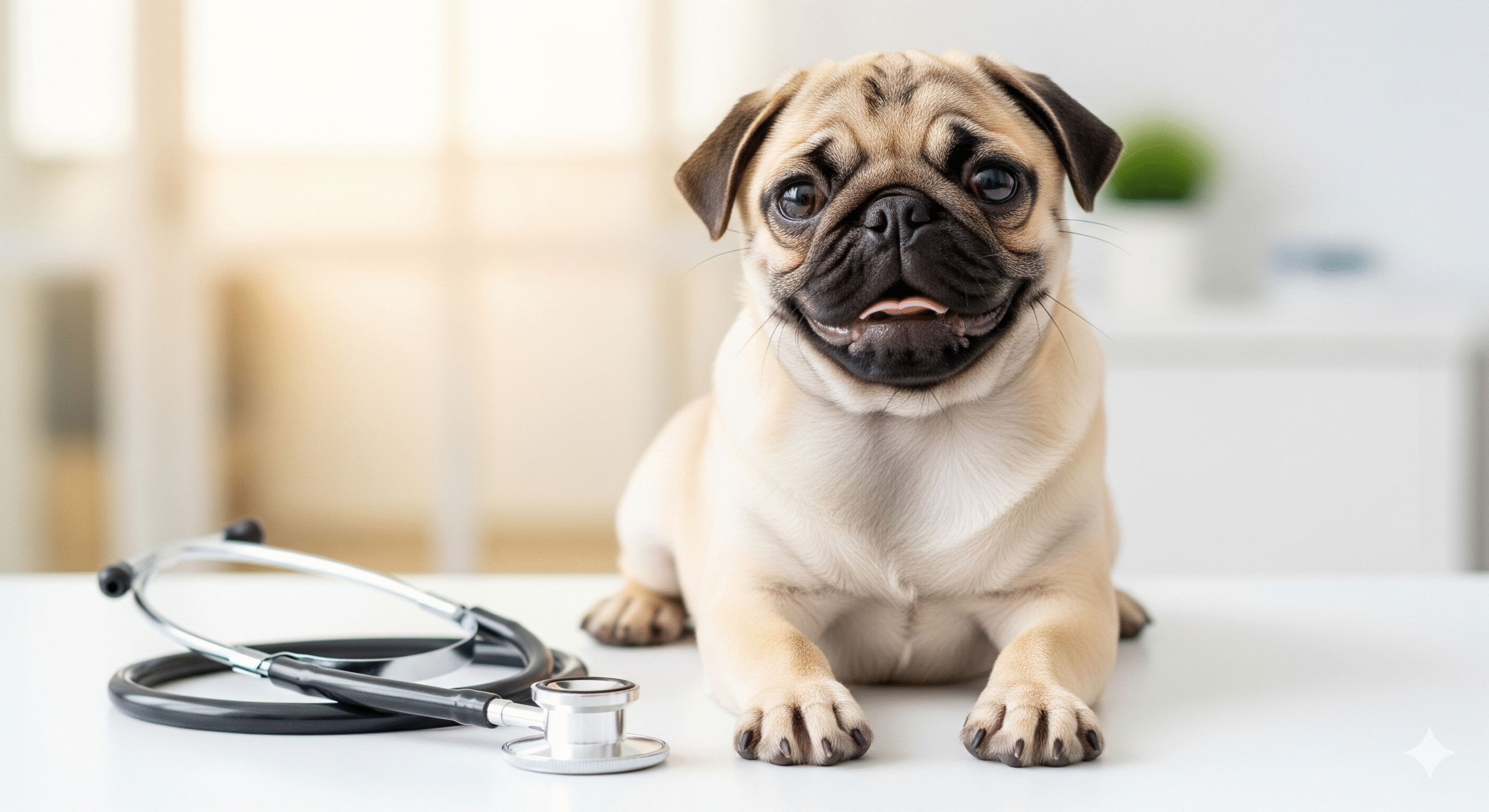With their wrinkled faces, big eyes, and charming personalities, Pugs have wiggled their way into millions of hearts. However, that adorable flat face (a trait known as brachycephaly) comes with a unique set of health challenges that every potential and current owner must understand. Proactive and informed care is not optional for a Pug; it’s essential for their quality of life. Breathing difficulties are the most significant concern, but they are far from the only one.
This comprehensive guide is your roadmap to navigating the specific health needs of a Pug puppy. We’ll move beyond general puppy advice and focus on the breed-specific knowledge that will help your Pug live a longer, more comfortable, and joyful life.
Here’s what we’ll cover:
✔️ Understanding Brachycephalic Obstructive Airway Syndrome (BOAS) and what it means for your Pug
✔️ Critical temperature and exercise management to prevent respiratory distress
✔️ A complete health checklist for Pug puppies, from eyes to skin folds
✔️ How to choose a responsible breeder to minimize genetic health risks
✔️ Emergency signs every Pug owner must know
✔️ Daily care routines to keep your Pug thriving
Let’s ensure your Pug’s snores are just a sign of contentment, not a cry for help.
The #1 Priority: Understanding Brachycephalic Anatomy & BOAS 🌀
To care for a Pug, you must first understand why they struggle to breathe. Their flat face is the result of a shortened skull, but the internal structures haven’t shortened proportionally. This crowds the airway, leading to Brachycephalic Obstructive Airway Syndrome (BOAS).
The Components of BOAS:
- Stenotic Nares: Excessively narrow or collapsed nostrils that restrict how much air can enter the nose.
- Elongated Soft Palate: The soft part at the back of the roof of the mouth is too long for the shortened skull. It can flop into the airway, obstructing the entrance to the windpipe.
- Hypoplastic Trachea: A windpipe that is narrower in diameter than it should be.
- Everted Laryngeal Saccules: Small pouches of tissue in the larynx that can get sucked into the airway due to the constant strain of pulling air through obstructions.
Every Pug has some degree of BOAS. The severity varies, and your job as an owner is to manage their environment to minimize its impact.
Daily Management: Protecting Your Pug’s Airways 🛡️
You can dramatically improve your Pug’s comfort and safety with a few key management strategies.
1. Heat & Humidity are the Enemy ☀️
Pugs are extremely prone to heatstroke because they cannot pant effectively to cool down.
- Never exercise your Pug in hot or humid weather. Walks should be during the coolest parts of the day (early morning or late evening).
- Always provide access to air conditioning and cool, shady spots.
- Avoid hot surfaces like asphalt, which can burn their paws and radiate heat.
- Invest in cooling mats or vests for summer.
2. Exercise: Quality Over Quantity 🚶♂️
- Short, gentle walks are better than long, strenuous ones.
- Use a harness, never a collar. A collar puts pressure directly on the trachea, which is often already compromised.
- Watch for signs of overexertion: Excessive panting, noisy breathing, lagging behind, a blue or purple tongue (a medical emergency).
3. Weight Management is CRITICAL ⚖️
This is the most important factor under your control. Excess fat accumulates in the neck and chest, further constricting the airway and making breathing immensely more difficult. Keep your Pug lean and muscular.
4. Stress Reduction 😥
Excitement, anxiety, and stress can all trigger rapid breathing and exacerbate airway issues. Create a calm, predictable environment for your Pug.
Beyond Breathing: The Pug Puppy Health Checklist 📋
1. Eye Care 👁️
Their large, protruding eyes are prone to injuries and conditions like:
- Corneal Ulcers: From scratching their eye or running into objects.
- Dry Eye (KCS): Inadequate tear production.
- Proptosis: The eye can pop out of the socket if scruffed too hard or involved in a trauma. THIS IS AN EMERGENCY.
- Care: Clean around the eyes daily with a soft, damp cloth. Monitor for redness, cloudiness, or squinting.
2. Skin Fold Dermatitis 🧴
The deep wrinkles on their face and body trap moisture, bacteria, and yeast, leading to painful infections.
- Care: Clean their skin folds daily with a soft cloth or cotton pad and a wrinkle-safe cleaner. Ensure the folds are thoroughly dried afterward.
3. Dental Health 🦷
Crowded, misaligned teeth are common due to the shortened jaw, leading to rapid plaque buildup and dental disease.
- Care: Daily tooth brushing is non-negotiable. Provide dental chews approved for their size and age.
4. Orthopedic Issues 🦴
- Hip Dysplasia: A malformation of the hip joint.
- Luxating Patella: A dislocating kneecap, often noticeable as a “skipping” gait.
Choosing a Healthy Pug Puppy: Responsible Breeding 🏆
The breeder you choose sets the foundation for your puppy’s health.
- Look for breeders who prioritize health over extreme features. Some modern breeders are aiming for slightly longer muzzles to improve airflow.
- Ask to see the parents. Do they breathe quietly at rest? Are they a healthy weight?
- The breeder should provide health clearances for the parents, including certifications from the Orthopedic Foundation for Animals (OFA) for hips and patellas, and an eye exam from a veterinary ophthalmologist.
- Avoid breeders who breed for “double curls” (extremely tight tail curls), as this is linked to hemivertebrae (spinal deformities).
Red Flags: When to Call the Vet Immediately 🚨
- Respiratory Distress: Labored breathing, heaving sides, inability to catch their breath, blue or purple gums/tongue.
- Eye Injury: Squinting, pawing at the eye, redness, cloudiness, or the eye being out of socket.
- Heatstroke: Excessive panting/drooling, bright red gums, lethargy, vomiting, collapse.
- Back Pain: Yelping, reluctance to move, or hind leg weakness (signs of IVDD).
Final Checklist for Pug Puppy Care ✅
☑️ I use a well-fitted harness, not a collar.
☑️ I exercise my Pug during cool parts of the day.
☑️ I clean their facial wrinkles every single day.
☑️ I am committed to keeping my Pug at a lean, healthy weight.
☑️ I have a plan for hot weather and know the signs of heatstroke.

Ready to Choose Your Travel Safety Gear? Now that you understand the importance of securing your puppy in the car, it’s time to find the right product for your vehicle and your pup’s size. The best gear will keep them safe and comfortable on every journey. For detailed reviews on crash-tested harnesses, booster seats, and travel crates, read our buyer’s guide: Puppy Car Seats & Travel Safety Gear.






